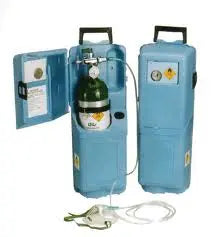Frequently Asked Questions (FAQ) About Emergency Oxygen



1. Why is emergency medical oxygen crucial during medical emergencies? During life-threatening emergencies, tissues and organs often suffer from low oxygen levels, leading to potential brain damage and other organ failure. Emergency medical oxygen, after ensuring an open airway, is vital in increasing survival chances by preventing cardiac arrest and supporting vital functions.
2. Who should receive emergency medical oxygen? Any individual experiencing a potentially life-threatening illness or injury should receive emergency medical oxygen without exception.
3. How is emergency medical oxygen administered? For breathing individuals, a mask is used to increase inhaled oxygen concentration. For non-breathing victims, oxygen is combined with rescue breathing via a CPR mask, enriching the oxygen content of the rescuer's breath, thus increasing the oxygen available to the victim.
4. When should emergency oxygen be administered? Emergency oxygen should be initiated immediately after ensuring a clear and open airway. If CPR is necessary and oxygen is delayed, continue with conventional rescue breathing until it's available. While automated external defibrillator (AED) use is a priority, simultaneous oxygen administration can enhance its effectiveness.
5. Can oxygen be harmful during medical emergencies? Oxygen is typically beneficial and not harmful during emergencies. Prolonged use (over 5 hours) may have potential adverse effects, but in acute situations, it is critical for all sudden life-threatening conditions.
6. Does emergency oxygen replace rescue breathing? No, in cases where the victim isn't breathing, oxygen must be used in conjunction with rescue breathing to be effective.
7. Is oxygen necessary after revival from CPR? Yes, continued oxygen administration post-revival can prevent a relapse into cardiorespiratory arrest until EMS arrives.
8. Should oxygen continue if the victim improves? Yes, maintaining oxygen until professional medical help arrives can prevent deterioration.
9. Can emergency oxygen replace the Heimlich Maneuver? No, physical obstruction must be cleared first. Oxygen is beneficial after clearing the airway to support recovery.
10. What to do if unsure of the victim's breathing status? Initiate rescue breathing with emergency oxygen immediately. Avoid waiting to see if the victim recovers on their own as this can lead to deterioration.
11. Should oxygen be applied if there's difficulty breathing but no arrest? Yes, applying oxygen to someone with labored breathing can be crucial in preventing further deterioration.
12. What if the victim can't tolerate an oxygen mask? Holding the mask close to the face can still provide significant benefits.
13. Does administering emergency oxygen require a prescription? No, the FDA exempts emergency oxygen from prescription requirements, but it must be administered by properly trained personnel.
14. Who can provide emergency oxygen? Anyone trained in its usage according to the manufacturer’s directions and FDA requirements.
15. What are the legal requirements for maintaining an emergency oxygen unit? Refillable cylinders require hydrostatic testing every five years, and disposable ones should never be refilled. Proper storage and handling as per federal regulations are essential.
16. Is oxygen dangerous? Oxygen itself doesn't catch fire or explode but supports and accelerates combustion. Proper handling ensures safety.
17. How much oxygen should be on-hand? Aim for a supply that lasts at least twice the average EMS response time to your facility, usually between 30 minutes to an hour.
18. What are OSHA's regulations on emergency oxygen? While there are no specific regulations, compliance with compressed gas storage and handling standards is required.
19. How does the OSHA Bloodborne Pathogen policy affect emergency oxygen? Follow the standard for cleaning or disposing of units or components contaminated with blood or potentially infectious materials.
20. If unsure about administering emergency oxygen, what should be done? When in doubt, administer it. The benefits of using it far outweigh the risks of not providing enough support. It's a non-harmful intervention that could be life-saving.


